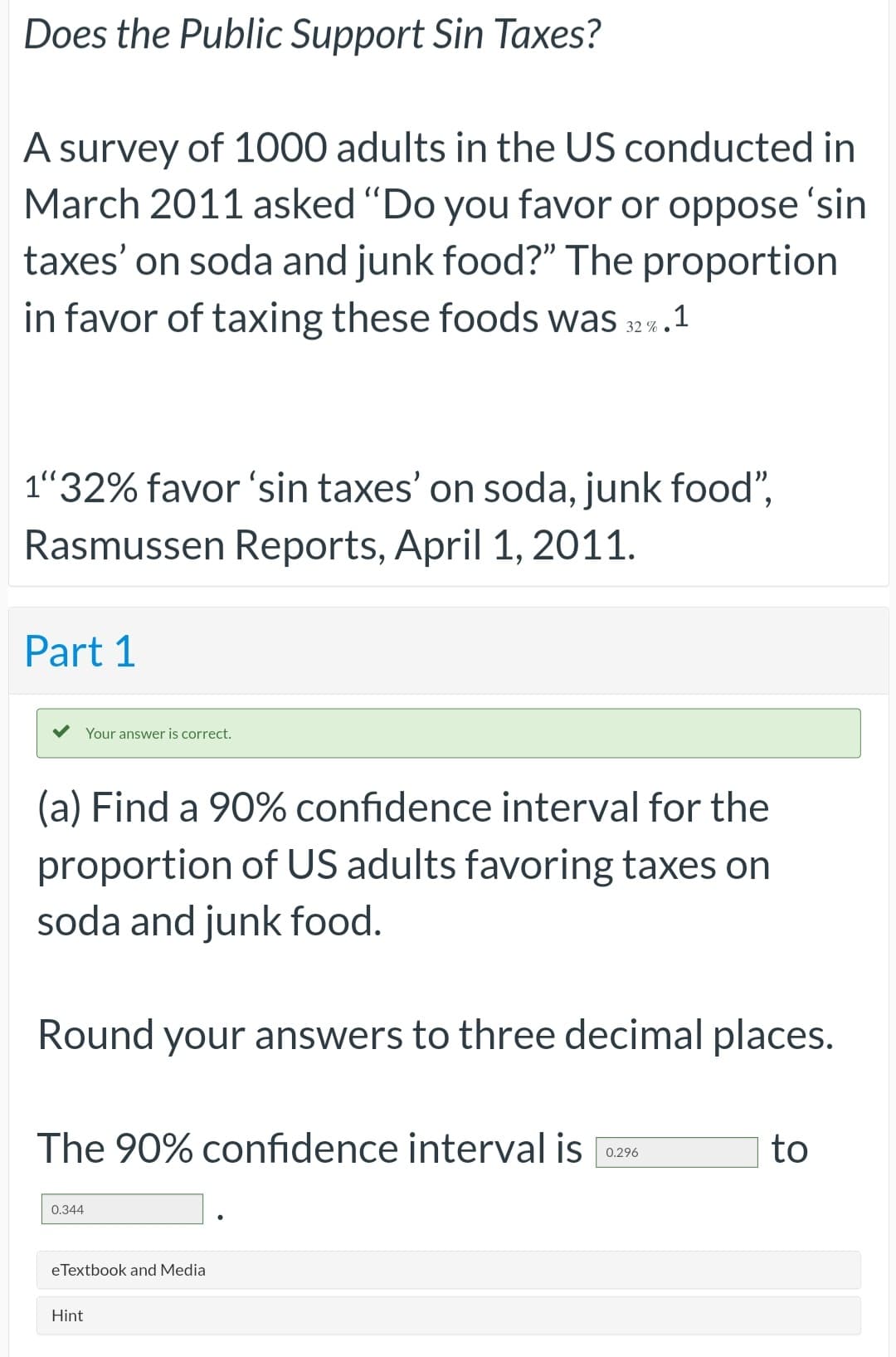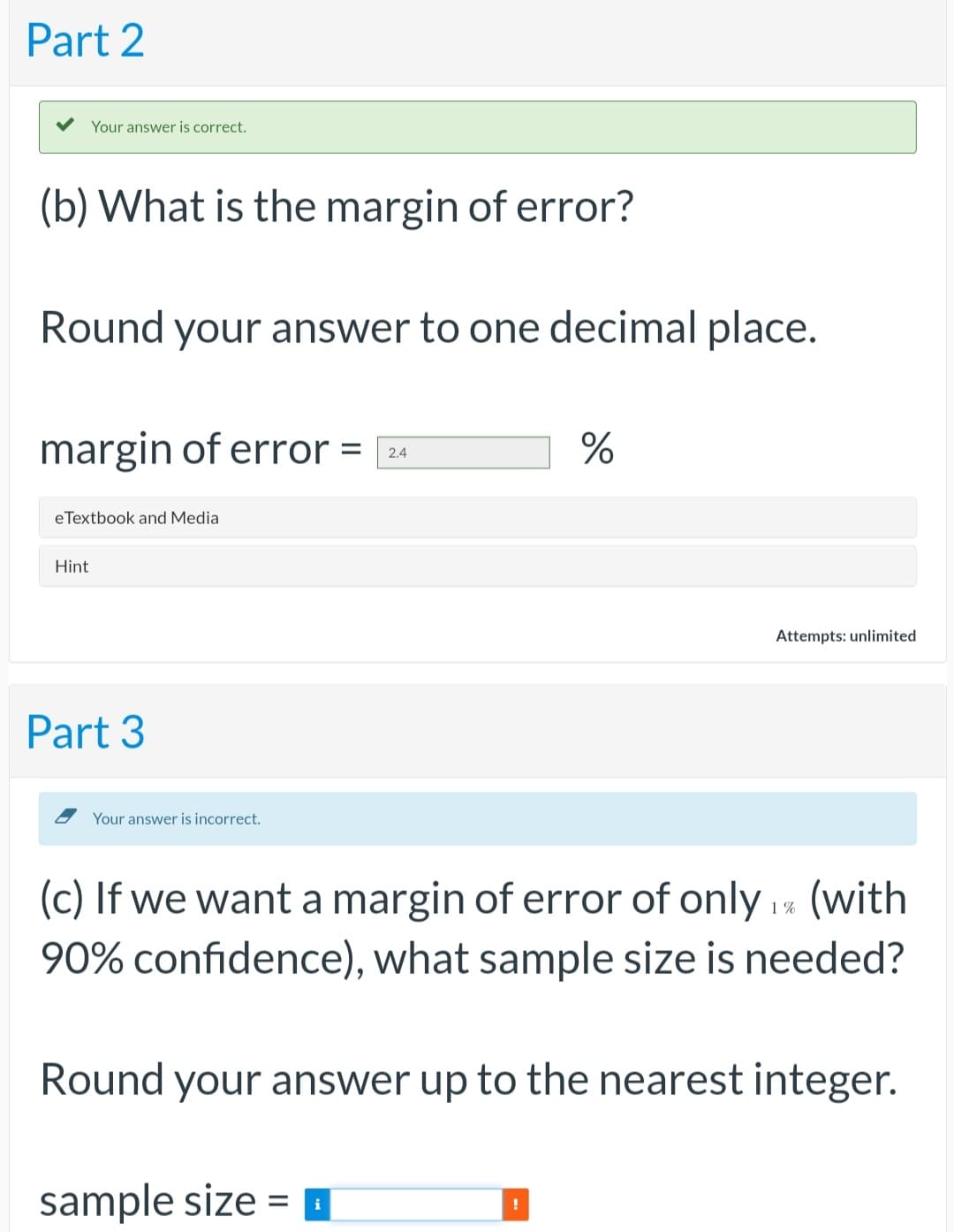Does the Public Support Sin Taxes? A survey of 1000 adults in the US conducted in March 2011 asked "Do you favor or oppose 'sin taxes' on soda and junk food?" The proportion in favor of taxing these foods was 32%.1 1"32% favor 'sin taxes' on soda, junk food", Rasmussen Reports, April 1, 2011. Part 1 Your answer is correct. (a) Find a 90% confidence interval for the proportion of US adults favoring taxes on soda and junk food. Round your answers to three decimal places. The 90% confidence interval is 0.296 0.344 e Textbook and Media to
Does the Public Support Sin Taxes? A survey of 1000 adults in the US conducted in March 2011 asked "Do you favor or oppose 'sin taxes' on soda and junk food?" The proportion in favor of taxing these foods was 32%.1 1"32% favor 'sin taxes' on soda, junk food", Rasmussen Reports, April 1, 2011. Part 1 Your answer is correct. (a) Find a 90% confidence interval for the proportion of US adults favoring taxes on soda and junk food. Round your answers to three decimal places. The 90% confidence interval is 0.296 0.344 e Textbook and Media to
MATLAB: An Introduction with Applications
6th Edition
ISBN:9781119256830
Author:Amos Gilat
Publisher:Amos Gilat
Chapter1: Starting With Matlab
Section: Chapter Questions
Problem 1P
Related questions
Question

Transcribed Image Text:Does the Public Support Sin Taxes?
A survey of 1000 adults in the US conducted in
March 2011 asked "Do you favor or oppose 'sin
taxes' on soda and junk food?" The proportion
in favor of taxing these foods was 32%. .1
1"32% favor 'sin taxes' on soda, junk food",
Rasmussen Reports, April 1, 2011.
Part 1
Your answer is correct.
(a) Find a 90% confidence interval for the
proportion of US adults favoring taxes on
soda and junk food.
Round your answers to three decimal places.
The 90% confidence interval is
0.344
eTextbook and Media
Hint
0.296
to

Transcribed Image Text:Part 2
Your answer is correct.
(b) What is the margin of error?
Round your answer to one decimal place.
margin of error = 24
eTextbook and Media
Hint
Part 3
Your answer is incorrect.
(c) If we want a margin of error of only 1% (with
90% confidence), what sample size is needed?
sample size =
%
Round your answer up to the nearest integer.
i
Attempts: unlimited
!
Expert Solution
This question has been solved!
Explore an expertly crafted, step-by-step solution for a thorough understanding of key concepts.
This is a popular solution!
Trending now
This is a popular solution!
Step by step
Solved in 4 steps with 3 images

Recommended textbooks for you

MATLAB: An Introduction with Applications
Statistics
ISBN:
9781119256830
Author:
Amos Gilat
Publisher:
John Wiley & Sons Inc

Probability and Statistics for Engineering and th…
Statistics
ISBN:
9781305251809
Author:
Jay L. Devore
Publisher:
Cengage Learning

Statistics for The Behavioral Sciences (MindTap C…
Statistics
ISBN:
9781305504912
Author:
Frederick J Gravetter, Larry B. Wallnau
Publisher:
Cengage Learning

MATLAB: An Introduction with Applications
Statistics
ISBN:
9781119256830
Author:
Amos Gilat
Publisher:
John Wiley & Sons Inc

Probability and Statistics for Engineering and th…
Statistics
ISBN:
9781305251809
Author:
Jay L. Devore
Publisher:
Cengage Learning

Statistics for The Behavioral Sciences (MindTap C…
Statistics
ISBN:
9781305504912
Author:
Frederick J Gravetter, Larry B. Wallnau
Publisher:
Cengage Learning

Elementary Statistics: Picturing the World (7th E…
Statistics
ISBN:
9780134683416
Author:
Ron Larson, Betsy Farber
Publisher:
PEARSON

The Basic Practice of Statistics
Statistics
ISBN:
9781319042578
Author:
David S. Moore, William I. Notz, Michael A. Fligner
Publisher:
W. H. Freeman

Introduction to the Practice of Statistics
Statistics
ISBN:
9781319013387
Author:
David S. Moore, George P. McCabe, Bruce A. Craig
Publisher:
W. H. Freeman